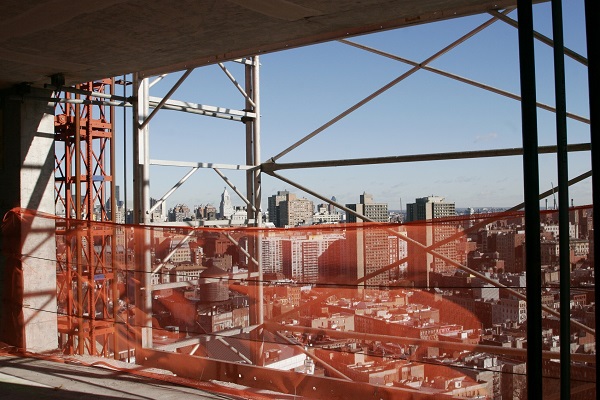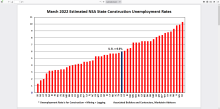
The not-seasonally adjusted US construction unemployment rate dropped 0.4% in March 2023 from a year ago, down from 6% to 5.6%, according to a state-by-state analysis of U.S. Bureau of Labor Statistics data released today by Associated Builders and Contractors (ABC). Thirty-two states had lower unemployment rates over the same period, five were unchanged, and 13 were higher.

National NSA payroll construction employment was 193,000 higher than in March 2022. From February 2022 through March 2023, seasonally adjusted construction employment was above its pre-pandemic peak of 7,608,000.
In October 2021, residential construction employment moved above its pre-pandemic peak, while nonresidential construction employment only recently did so in February 2023. March 2023 SA residential payroll construction employment was 265,000 above its pre-pandemic height, while nonresidential payroll construction employment was 12,000 above its pre-pandemic peak.
In March 2023, 31 states had lower construction unemployment rates compared to March 2019 (pre-pandemic), 18 states had higher rates, and Utah’s rate was the same.
“High-interest rates are adversely affecting demand for single-family housing and creating headwinds for nonresidential construction projects,” said Bernard Markstein, president and chief economist of Markstein Advisors, who analyzed ABC. “Until recently, construction employment continued to grow as builders worked on their backlog of projects. The March construction employment numbers were the first indication that employment growth in construction may be turning negative. The likely increase in the Federal Reserve’s target federal funds rate by a quarter of a per cent at its next meeting and various lenders tightening standards for commercial construction projects will be a negative for the industry and construction employment. However, the increased funds flowing from the federal Infrastructure Investment and Jobs Act to states and localities will partially offset the downward pressure, providing opportunities for some unemployed workers and companies.”

National and state unemployment rates are best evaluated year-over-year because these industry-specific rates are not seasonally adjusted. However, due to the COVID-19 pandemic, high and rising interest rates and other national and international disruptions, month-to-month comparisons offer insight into the rapidly shifting economic environment for construction employment.
In March 2023, 43 states had lower estimated construction unemployment rates than in February, four states had higher rates, and three (Minnesota, Montana and Utah) had the same rate.
The five states with the lowest March 2023 estimated NSA construction unemployment rates were:
- Colorado, 1.4%
- South Dakota, 1.5%
- Nebraska, 1.9%
- Utah, 2.4%
- Tennessee, 2.7%
All these states posted their lowest March NSA construction unemployment rate on record except for Utah. Tennessee matched its lowest March construction unemployment rate set last year. South Dakota had the biggest monthly drop in its rate, down 4.3%.
The states with the highest March 2023 estimated NSA construction unemployment rates were:
- Michigan, Pennsylvania and Wyoming (tied), 8%
- Rhode Island, 8.2%
- Nevada, 9%
- Ohio, 9.3%
- Alaska, 13.4%
Michigan and Rhode Island notched their lowest March construction unemployment rate on record. Pennsylvania had the second largest monthly decline in its rate (down 3.8%), behind South Dakota.
Click here to view graphs of overall unemployment rates (Tab 1) and construction unemployment rates (Tab 2) showing the impact of the COVID-19 pandemic, including a graphing tool that creates a chart for multiple states. To better understand the basis for calculating unemployment rates and what they measure, check out the Background on State Construction Unemployment Rates.










